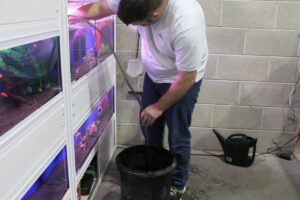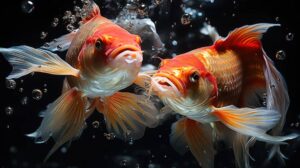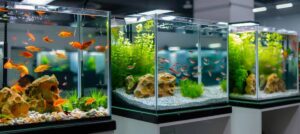The Pets Care Blog
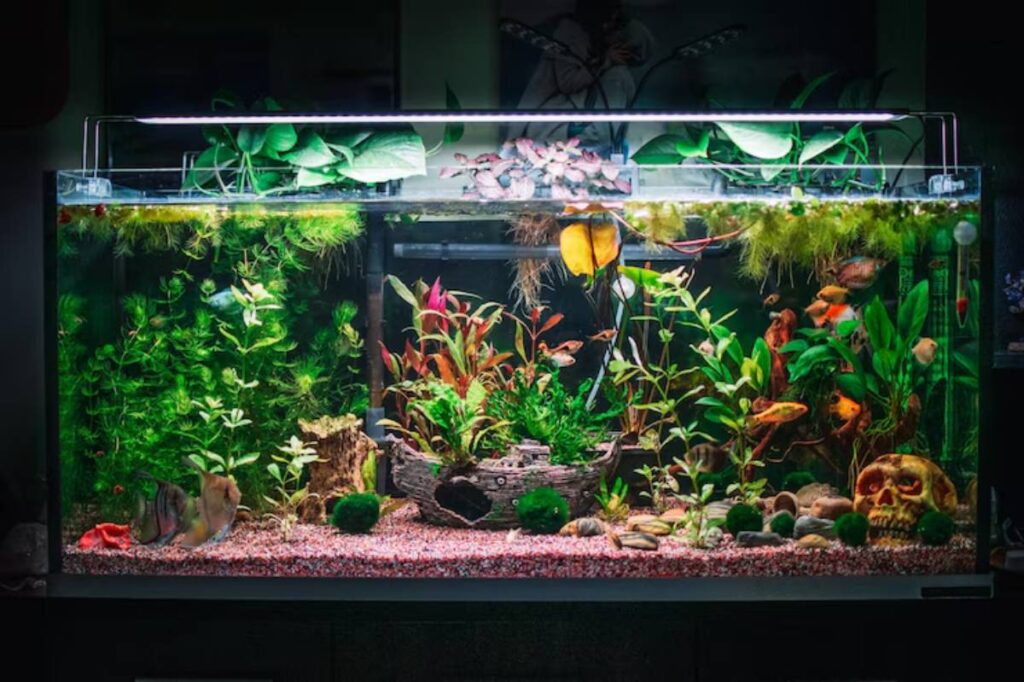
Avoiding Sunlight: Tank Placement Mistakes to Avoid
That warm, sunlit corner by the window might seem like the perfect place to showcase your new aquarium. The natural light highlights your aquascape, your fish gleam in the sunshine — what could go wrong?
Plenty, actually.
While it may look idyllic, placing your tank in direct or even partial sunlight is one of the most common — and costly — mistakes new aquarists make. Poor placement can lead to stubborn algae blooms and risky temperature changes. These issues can upset your aquarium’s delicate balance.
This guide explains how sunlight affects fish tanks. We’ll discuss why direct light can cause ongoing issues and how to choose the right spot for your aquarium to ensure its health and stability. If you’re a first-time fishkeeper or getting a bigger tank, these tips will help you set up your aquarium right and keep your fish safe.
Why Sunlight and Aquariums Don’t Mix
Fish tanks are closed ecosystems. They are balanced and sensitive to small changes in the environment. Sunlight, while natural and pleasant, introduces a mix of problems that your equipment may struggle to counteract.
The Main Risks of Sunlight Exposure:
- Excessive algae growth: Algae thrive on light, and direct sunlight supercharges their spread. You might notice green water, fuzzy growth on your glass, or stringy algae on plants.
- Temperature changes: Sunlight can quickly heat your tank, especially in small or shallow tanks. Most aquarium heaters work to warm water, but few systems are built to cool it.
- Stressful light cycles: Unlike controlled LED lights on timers, the sun’s schedule is inconsistent. Shadows, glare, and varying intensity can disrupt your fish’s circadian rhythms.
- Evaporation and mineral build-up: Sunlight speeds up evaporation. This causes hard water stains, unstable salinity in marine tanks, and a need for more frequent top-ups.
These effects might not show up right away. But over time, they can harm your tank’s stability. This makes maintenance tougher and raises the chances of disease or equipment failure.
How Sunlight Triggers Algae Blooms
Algae are photosynthetic organisms. Provide light, nutrients (such as nitrate and phosphate), and warm water. They will multiply quickly, often faster than your plants or filter can handle.
Sunlight speeds this up in three ways:
- Stronger intensity than LED or fluorescent tank lights
- Longer exposure, especially in summer months or unshaded windows
- Uneven coverage, which encourages algae to target the glass or floating surfaces
Once algae take hold, it can:
- Block light from reaching plants
- Coat decorations and glass, reducing visibility
- Compete with live plants for nutrients
- Drive down oxygen levels at night
If your tank is near a window and algae keeps coming back despite cleaning, sunlight is likely to blame.
Common Tank Placement Mistakes (and How to Avoid Them)
Understanding what not to do is just as helpful as knowing best practices. Here are some of the most common placement errors involving light exposure and how to avoid them.
1. Placing Tanks Directly in Front of a Window
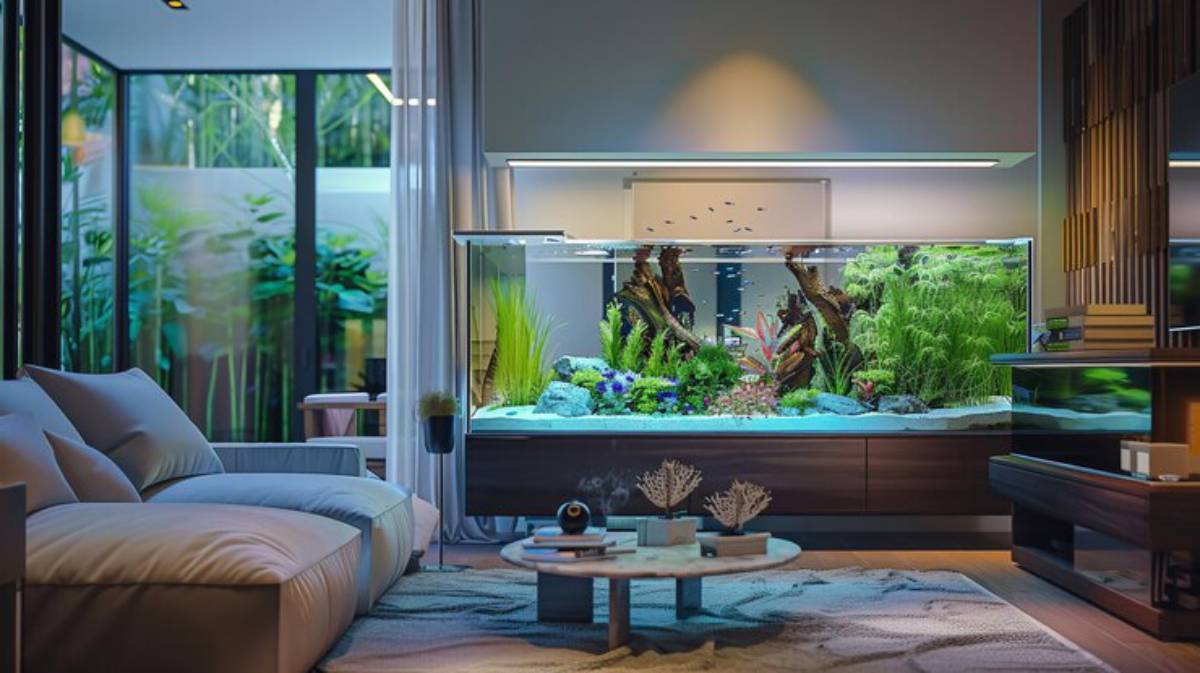
It’s a classic mistake: “The natural light will be good for the fish!” Unfortunately, this location almost guarantees algae issues and inconsistent temperatures.
Solution: Move the tank next to a wall by the window. You can also use blackout curtains during the day.
2. Using Glass Tables or Reflective Surfaces
Sunlight can reflect off shiny floors or glass furniture. This hits your tank at strange angles and increases exposure.
Solution: Use a wooden or matte-finished stand. Alternatively, place the tank where glare isn’t an issue.
3. Partial Shade Near South- or West-Facing Windows
Even if only a corner of your tank gets sun for a few hours, algae can still gain a foothold, and uneven heating can occur.
Solution: If you can’t change the room placement, try using a backing film or aquarium vinyl on that side.
4. Neglecting to Check Sun Position Year-Round
A tank that’s fine in winter may catch summer rays when the sun shifts.
Solution: Before finalising tank placement, check potential locations in different seasons and at various times of day.
Where to Place Your Tank Instead
So, where should you put your aquarium? The goal is to find a location that’s visually appealing, stable, and shielded from direct sunlight.
Best placement practices:
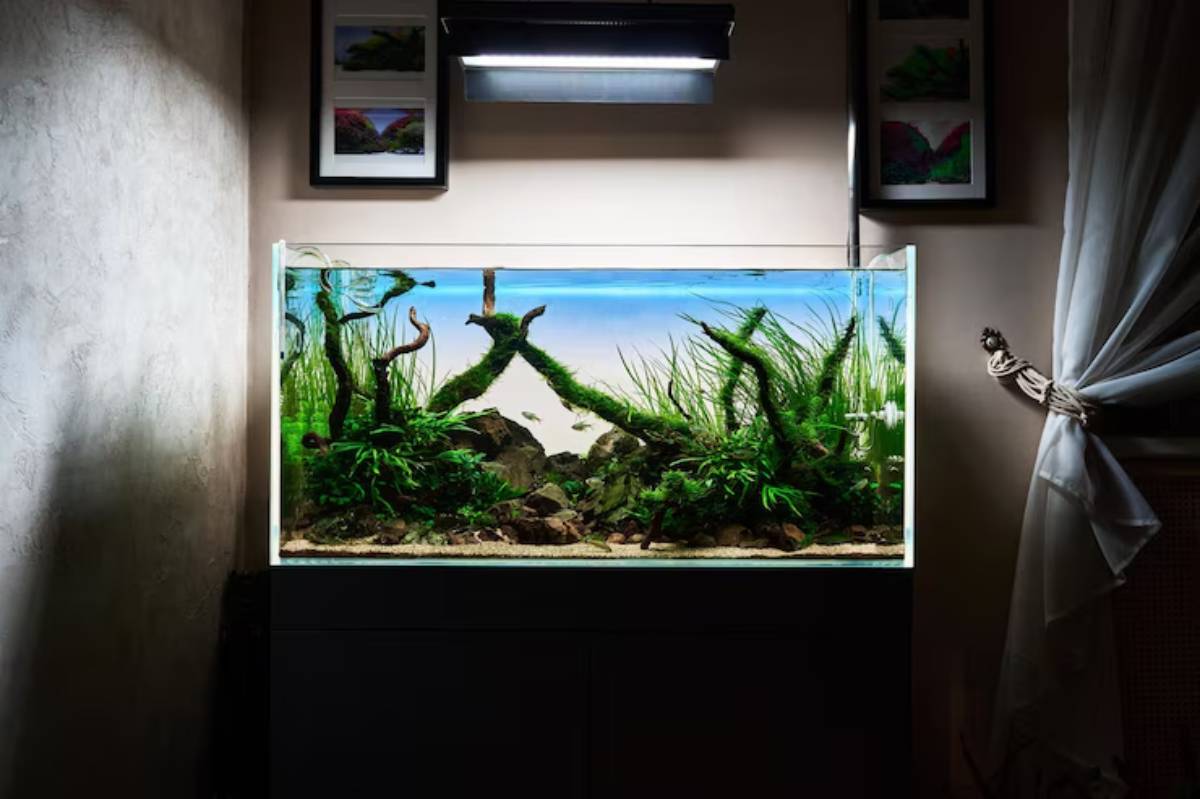
- Choose a wall that receives no direct sunlight throughout the day
- Keep the tank at least 1–2 metres from windows or doors
- Use a north-facing wall, which receives the least natural light in the Northern Hemisphere
- Avoid spots near radiators, fireplaces, or air conditioning vents
Ensure the space allows for easy access to power outlets, filtration maintenance, and daily observation. For more general setup tips, explore Best Room Conditions for Aquariums.
How to Manage Light Without Sunlight
You might wonder — if sunlight is bad, what kind of light should your aquarium have?
Choose an artificial light setup that offers:
- Controlled timing (use a timer or smart plug)
- Consistent intensity tailored to your tank size and plant needs
- Balanced spectrum (white or full-spectrum LEDs are ideal for planted tanks)
- Low heat output to avoid extra temperature stress
Your goal is to mimic a natural day-night cycle. Aim for 8–10 hours of light and 14–16 hours of darkness.
Avoid leaving the lights on all day or turning them off irregularly. Inconsistent lighting stresses fish and promotes algae, just like sunlight.
Algae Prevention Beyond Light Control
Sunlight isn’t the only factor behind algae, but it’s one of the easiest to control. If you’re still seeing blooms, look at these other factors.
Nutrient excess:
- Overfeeding
- Rare water changes
- Poor plant competition
Equipment issues:
- Old light bulbs (past their spectrum life)
- Dirty or clogged filters
- Insufficient CO₂ (in planted tanks)
Keep up with regular water changes (20–30% weekly), remove decaying plant matter, and feed your fish sparingly to reduce nutrient levels.
You can add algae eaters like nerite snails or ottos. But remember, they should support your strategy, not take the place of good practices.
Exceptions: When Controlled Sunlight Might Be Useful
There are rare cases where limited, indirect sunlight can be tolerated — or even helpful.
- Heavily planted tanks with nutrient control and CO₂
- Aquariums with shaded zones, such as floating plants or frosted glass backing
- Tanks with algae grazers, such as Amano shrimp or plecos
In these cases, the setup must be carefully balanced, and algae must still be monitored closely. If you’re not ready to manage those variables, it’s best to avoid sunlight entirely.
Conclusion: Sunlight Might Be Free, But It’s Not Friendly
When planning your aquarium layout, it’s tempting to focus on convenience or looks. However, keeping your aquarium healthy over time relies on consistency. And nothing disrupts that more than uncontrolled sunlight.
Put your tank in a place with steady light, little temperature change, and low sunlight. This helps keep your fish calm and stops algae growth. Controlled, artificial lighting always wins over unpredictable sunbeams.
So, before filling your tank, take a moment to study your space. Where does the sun fall? Which areas remain stable year-round? That extra bit of planning could save you hours of cleaning and frustration later on.
Along with avoiding sunlight, make sure your aquarium is on a stable surface. Weight Considerations When Placing Aquariums can help you evaluate flooring and stand safety before you start.
Got a placement dilemma or room layout you’re unsure about? Drop a comment below — let’s find the best spot for your fish together.




